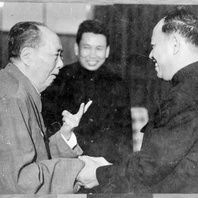
Item
Mao Zedong with Pol Pot and Ieng Sary
This picture shows Mao Zedong with Pol Pot and Ieng Sary during the visit of the Khmer Rouge leaders to Beijing in June 1975. It was featured in the publication (French and English versions) entitled The People’s Republic of Kampuchea (1979). According to the caption which accompanied the image in that publication, the photograph was part of the archives found by the Vietnamese and Kampuchea United Front for National Salvation troops at the Bureau of the Central Committee of the Communist Party of Kampuchea (Office code 870). Mao is shown congratulating Ieng Sary and Pol Pot and, according to the original caption, saying: “Comrades, you have achieved a prodigious victory. In one go, no more classes!” This photograph is part of the collection held by the Agence Khmère de Presse (AKP) and Cambodia’s Ministry of Information. This collection, which documents the early years of the People’s Republic of Kampuchea as photographed by the Vietnamese and a small team of Cambodian photographers, has not yet been classified or indexed.
Read More
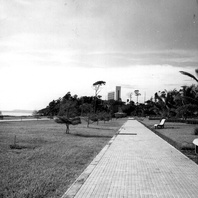
Featured Item
Independence Beach Promenade, Sihanoukville
This photograph of Independence Beach Promenade with the Independence Hotel in the background is part of the collection that was donated to the National Archives of Cambodia from the Library of the Royal University of Fine Arts by Darryl Collins and Helen Grant Ross in 2003. The collection was used by Collins and Ross for their research into urbanisation. The images were probably originally used to mount the Sangkum Reastr Niyum Permanent Exhibition at the Exhibition Hall, Bassac area, Phnom Penh.
Read More
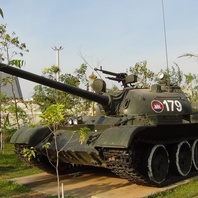
Item
Soviet-era tank, Win-Win Monument
This photograph shows an armoured tank on display on the southern side of the Win-Win Monument complex. The Win-Win Monument complex – photographed here in January 2020 – was inaugurated in December 2018 to mark the twentieth anniversary of the end of the post-Democratic Kampuchea civil war, with the final defection of the remaining Khmer Rouge factions, thanks to the DIFID policy (“Divide, Isolate, Finish, Integrate, Develop”) also known as the “Win Win” policy of Prime Minister Hun Sen.
Read More
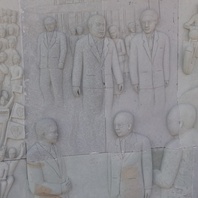
Item
Win-Win Monument bas-relief
This photograph shows a detail of the UNTAC -themed bas-relief on the 117-metre-long engraved base of the Win-Win Monument. It focuses on the Paris Peace Agreements (October 1991),and the (unofficial) meeting between Prince Norodom Sihanouk and Hun Sen. The Win-Win Monument complex – photographed here in January 2020 – was inaugurated in December 2018 to mark the twentieth anniversary of the end of the post-Democratic Kampuchea civil war, with the final defection of the remaining Khmer Rouge factions, thanks to the DIFID policy (“Divide, Isolate, Finish, Integrate, Develop”) also known as the “Win Win” policy of Prime Minister Hun Sen.
Read More
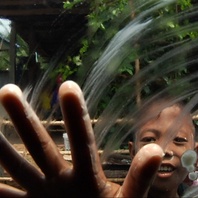
Essay
Bodies of Occupation: Conversation with Nontawat Numbenchapol
This conversation with the film director Nontawat Numbenchapol on his movie Boundary (2013), which follows a young soldier called in Bangkok to break up the “red shirts” protest (2011) to his hometown in Sisatek, a zone of conflict between Thailand and Cambodia due to the ongoing political dispute between the two countries over the Preah Vihear Temple. Boundary was funded by Busan International Film Festival and Art Network Asia. Numbenchapol received the Young Filmmaker award from the Bangkok Critics Assembly and Boundary screened across many film festivals such as Berlin International Film Festival, International Documentary Film Festival Amsterdam (IDFA), and Yamagata International Documentary Film Festival. Still from Nontawat Numbenchapol’s film Boundary (2013), courtesy of the artist Nontawat Numbenchapol’s movie Boundary (2013) will be accessible online on 5 October for 48 hours. Participants Brian Curtin is an Irish-born art writer, lecturer and curator of contemporary arts. He holds a PhD in studio art from the University of Bristol and has been based in Bangkok since 2000. Brian’s work explores dialogues between contemporary art, Queer theories and studies in visual and material cultures. His commentary, essays, interviews and reviews have been published in Art Journal, Artforum, Art Asia Pacific, Circa, Craft Research, Flash Art, Frieze, Journal of Curatorial Studies and Parachute and elsewhere. Published profiles of artists include Alice Maher, Paul Pfeiffer, Araya Rasdjarmrearnsook, Collier Schorr, Jakkai Siributr, and Apichatpong Weerasethakul. His monograph Essential Desires: Contemporary Art in Thailand was published by Reaktion Books in 2021. Brian’s research addresses challenges in thinking through hierarchies and antagonisms that limits critical approaches to modern and contemporary art; and published essays in this respect explore the art-historical marginalising of “decoration” and also problems of national identity as a frame for recent art. Brian has presented at conferences and symposia in Kuala Lumpur, Kyoto, London and Singapore. He has held writer’s residencies in Beijing and Kuala Lumpur. Curated exhibitions include China, New York, Korea and Britain as well as regionally in Southeast Asia. He managed the experimental venue H Project Space in Bangkok from 2011 to 2018 which now functions under the mantle Brian Curtin Projects. Curatorial work has been funded by the Arts Council England and Australia Council for the Arts. Brian has been a nominator for the Prix Pictet award in photography, the Sovereign Art Prize, and collaborations with Saatchi Gallery London. He has lectured in art history, visual culture and studio courses at the Faculty of Architecture of Chulalongkorn University, Bangkok, since 2006. In 2018 Brian led Uncommon Pursuits: A Temporary School for Emergent Curators in Southeast Asia at Sàn Art, a non-profit in Ho Chi Minh City (his website). May Adadol Ingawanij is a writer, curator, and teacher and Professor of Cinematic Arts at University of Westminster, where she co-directs the Centre for Research and Education in Arts and Media. She works on decentered histories and genealogies of cinematic arts; avant-garde legacies in Southeast Asia; forms of potentiality and future-making in contemporary artistic and curatorial practices; aesthetics and circulation of artists’ moving image, art, and independent films in, around, and beyond Southeast Asia. Ingawanij’s recent publications include articles on the Karrabing Film Collective, Nguyen Trinh Thi and Araya Rasdjarmrearnsook. Her curatorial projects include Animistic Apparatus and Lav Diaz: Journeys. She is writing a book entitled Animistic Medium: Contemporary Southeast Asian Artists Moving Image. Nontawat Numbenchapol (b. 1983, Bangkok) is a Thai film director and television screenwriter who is widely recognised for his documentary work. He graduated from the Visual Communication Design Department, Faculty of Art and Design, Rangsit University. Numbenchapol’s second documentary By the River, about the Klity villagers affected by water lead contamination. It became the first Thai film to receive the Special Mention award from the Locarno International Film Festival.In 2016 Numbenchapol created an hybrid docu-fiction #BKKY, a story of a teenage girl, “Jojo”, questioning life and identity. Jojo’s character is a compilation of 100 teenagers interviewed in Bangkok about their loves and dreams and coming-of-age just after graduating high school. It premiered in October 2016 at the Busan International Film Festival before it received the Jury Award for best feature- length film from Lesbisch Schwule Filmtage Hamburg, Germany. His Mobile Lab Project experiments and researches on new ways of human visual and sound perception different from normal human perception. The project researches historical, social, and political information recorded over many generations until they became living belief systems. The project aims to change the perception of those beliefs via recording and expression onto visual and aural media. The purpose is to open the minds of people who receive communications from Mobile Lab, so that there is always the another side of established beliefs and new beliefs can rise up.
Read More

Item
H. E. Mr Wang Ching-wei
This supplement was published by the Ministry of Publicity (Xuanchuanbu) on the very day that Wang Jingwei officially “returned” to Nanjing to take up the reins of government under Japanese occupation. The symbols attached to this image (e.g., the KMT “white sun” ensign, and the colours of the ROC flag) suggest a “return” to pre-war norms. The presence of the Japanese is not so much as mentioned here.
Read More

Item
Xin Zhonghua huabao (New China Pictorial) cover, March 1944
This cover image from the Xin Zhonghua huabao (New China Pictorial) 6.3 (March 1944) shows a colourised photograph of Wang Danfeng. Wang was a popular film celebrity in wartime Shanghai. The New China Pictorial was a bilingual (Chinese-English) magazine published from 1939 through 1944 in Shanghai by the occupation journalist Wu Linzhi for distribution in China and throughout Southeast Asia.
Read More
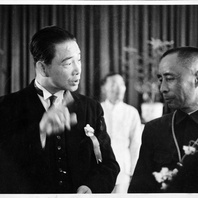
Item
Wang Jingwei with Zang Shiyi
Zang Shiyi (right), the Manchukuo ambassador to the RNG, speaks to Wang Jingwei prior to the both men signing the Japan-Manchukuo-China Joint Declaration on 30 November 1940, through which RNG China recognised Manchukuo. The Declaration was attached to the Sino-Japanese Basic Treaty, through which Japan formally recognised the RNG. Both documents were signed within the main RNG government compound in Nanjing.
Read More
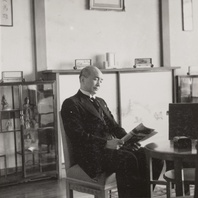
Item
Chu Minyi in his office
In this staged photograph, the RNG foreign minister Chu Minyi is pictured reading a magazine in his office, with a photographic portrait of Wang Jingwei on the wall behind his desk, and Buddhist objets d’art in a cabinet behind him.
Read More
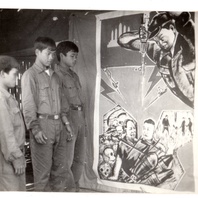
Featured Item
Three men looking at a propaganda poster
This picture shows three young male soldiers looking at a poster that represents a soldier of the Kampuchea United Front for National Salvation (KUFNS, also known as FUNSK) [Front or Renakse] aiming his rifle with bayonet at the enemies, Pol Pot and Ieng Sary. The drawing next to Pol Pot’s head is a reproduction of a photograph of killings by Khmer Rouge guards that were published between April 1976 and January 1978 in the mainstream Western media. Different stories circulated about the origin of those pictures. Some said they had been smuggled out of Cambodia by a relative of the photographer, who himself had died while trying to escape, or by a Cambodian refugee in Paris who refused to reveal his identity. According to Sygma Photo News (the agency which had distributed the original pictures), the images came from Khmer Rouge defectors. In fact, the photos had first appeared in a Thai newspaper in April 1976 and were reprinted in the Bangkok Post under the headline “True or false?” a few days later. The newspaper explained that they had first refused to buy the images from the Thai trader who tried to sell them because they had doubted their authenticity. Even American intelligence services thought the pictures were fake. The photographs, it turned out, were part of an operation by the Thai intelligence services. They had been staged and taken in Thailand. This photograph is part of the collection held by the Agence Khmère de Presse (AKP) and Cambodia’s Ministry of Information. This collection, which documents the early years of the People’s Republic of Kampuchea as photographed by the Vietnamese and a small team of Cambodian photographers, has not yet been classified or indexed.
Read More

Featured Item
Three men beside a propaganda poster
This photograph shows of three young soldiers standing next to a poster representing two soldiers (a man and a woman) from the Kampuchea United Front for National Salvation (KUFNS, also known as FUNSK) [Front or Renakse] fighting against the Khmer Rouge-Chinese enemy. The three soldiers stand at the entrance to a hut. The poster is about 1.80 metres in height. It is pinned on the hut’s external wall. It shows a female soldier and a male soldier standing below the Kampuchea United Front for National Salvation flag. The female soldier points her rifle to the bottom of the poster, at the enemy. The latter is clad in black and wears a krama (traditional scarf). He is obviously a Khmer Rouge fighter. The writing in Khmer, at the centre of the poster, reads: “Fight for victory”. This photograph is part of the collection held by the Agence Khmère de Presse (AKP) and Cambodia’s Ministry of Information. This collection, which documents the early years of the People’s Republic of Kampuchea as photographed by the Vietnamese and a small team of Cambodian photographers, has not yet been classified or indexed.
Read More
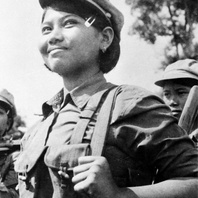
Item
Female soldier of the Kampuchea United Front for National Salvation
This unattributed photograph shows an unidentified young Cambodian female soldier of the Kampuchea United Front for National Salvation (KUFNS, also known as FUNSK) [Front or Renakse]. She is smiling and holds firmly the straps of her rucksack. This photograph is part of the collection held by the Agence Khmère de Presse (AKP) and Cambodia’s Ministry of Information. This collection, which documents the early years of the People’s Republic of Kampuchea as photographed by the Vietnamese and a small team of Cambodian photographers, has not yet been classified or indexed.